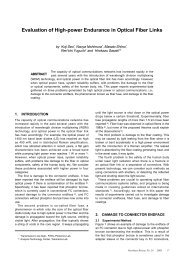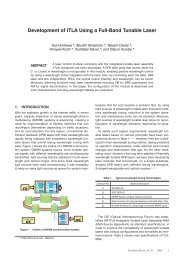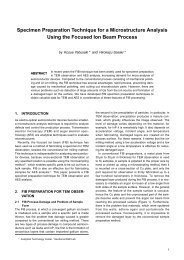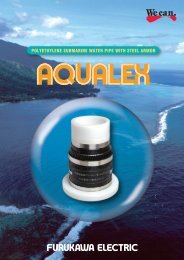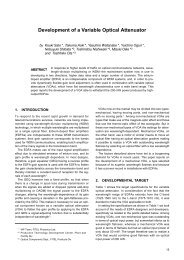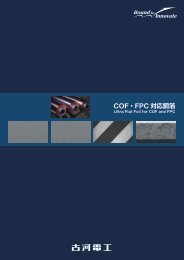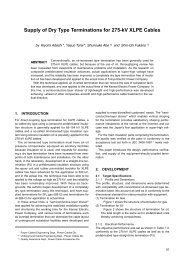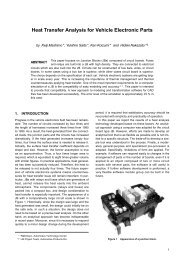Underground Power Cable, Distribution Cable, Overhead
Underground Power Cable, Distribution Cable, Overhead
Underground Power Cable, Distribution Cable, Overhead
Create successful ePaper yourself
Turn your PDF publications into a flip-book with our unique Google optimized e-Paper software.
<strong>Underground</strong> <strong>Power</strong> <strong>Cable</strong>, <strong>Distribution</strong> <strong>Cable</strong>, <strong>Overhead</strong> Transmission Line, Industrial <strong>Cable</strong> and Their Accessories<br />
joint: 240 phase, maximum span: 1,800 m), as well as in<br />
outgoing lines from power plants. Figure 2 shows a scene<br />
of cable installation for the Kan’nagawa Hydraulic <strong>Power</strong><br />
Plant of Tokyo Electric <strong>Power</strong> Company in 2003. Because<br />
the cable was so long in unit length as to reach 1,800 m,<br />
ordinary methods were unable to deal with its transportation.<br />
Accordingly, the cable was transported from the<br />
manufacturing plant to Hitachi Port by sea, and from<br />
where to the power plant by land using a special-purpose<br />
vehicle under a restriction of nighttime-only traveling,<br />
spending an unprecedentedly long transportation time of<br />
seven days.<br />
With respect to connection with the power equipment,<br />
an inverted type of gas-immersed termination joint was<br />
needed, so that we developed a new joint after reviewing<br />
its inner structure, having succeeded in delivery ahead of<br />
other manufacturers.<br />
We have accumulated several track records of 500-kV<br />
XLPE cables domestically since then, and having gained<br />
a foothold in overseas market through our recent delivery<br />
to China, we plant to receive more orders from overseas.<br />
1.2 <strong>Cable</strong> Downsizing and Capacity Increase<br />
We have developed jointly with Tokyo Electric <strong>Power</strong><br />
Company the Triplex-type XLPE cable having a sectored<br />
cross-section shown in Figure 3, and have applied the<br />
cable to many practical transmission lines since 1998. It<br />
was intended that the new cable design would be applied<br />
to increase the transmission capacity (i.e., increasing the<br />
Figure 2 Installation of a long-length cable using a specialpurpose<br />
vehicle.<br />
Figure 3 Appearance of sectored Triplex-type XLPE cable.<br />
conductor size) while making efficient use of existing<br />
cable conduits, because the costs related with civil engineering<br />
work to construct new cable conduits were very<br />
expensive. This development has made it possible to<br />
apply 500-mm 2 sized cables to those transmission lines<br />
where the maximum cable size was limited to 325 mm 2<br />
due to the duct size restriction, thereby achieving a<br />
capacity increase.<br />
1.3 Large-Sized Triplex-type XLPE <strong>Cable</strong><br />
Although the largest conductor size of Triplex-type XLPE<br />
cables was conventionally limited to 600 mm 2 due to<br />
manufacturing difficulties, we have overcome these problems<br />
and subsequently investigated the characteristic<br />
thermal behavior of large-sized segmented conductor<br />
cables at the time of stranding. As a result, taking into<br />
account these results in installation design, we were able<br />
to expand the size of 66-kV and 154-kV Triplex-type<br />
XLPE cables up to 1,000 mm 2 . The specification based on<br />
these results has been adopted since 2005 as a standard<br />
for practical lines, resulting in a number of improvements<br />
such as reducing the space for cable accommodation,<br />
efficiency increase in cable laying (i.e., enabling laying of<br />
three phases in a shorter period of time), reducing the line<br />
construction costs and downsizing of manholes due to<br />
elimination of cable offset.<br />
1.4 DC XLPE <strong>Cable</strong><br />
There is much need for DC transmission cables for its<br />
higher power transmission efficiency with no AC losses.<br />
Until recently, AC power transmission was preferred to DC<br />
transmission due to the fact that AC-DC power converters<br />
to be installed at either end of the cable line are expensive<br />
thus causing an increase in total construction cost. As the<br />
cost of power converter decreases, however, application<br />
of DC power transmission is expected to expand.<br />
But, in developing DC XLPE cables, it was found that<br />
the AC insulation material (i.e., cross-linked polyethylene)<br />
was not directly applicable to DC cables due to the problem<br />
of space charge accumulation within the insulation<br />
material. Accordingly, we have developed a DC insulation<br />
material which can control space charge accumulation,<br />
and have confirmed that the prototyped DC 250-kV and<br />
500-kV XLPE cables are provided with superior electrical<br />
properties including long-term characteristics.<br />
Figure 4 Large-sized Triplex-type XLPE cable and its installation.<br />
Furukawa Review, No. 32 2007 3





